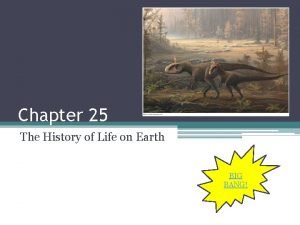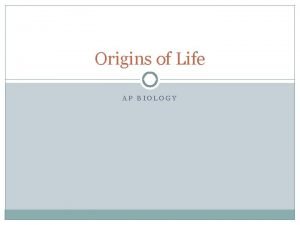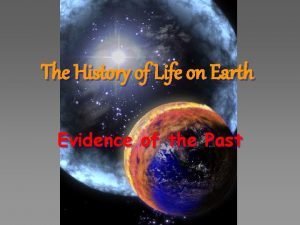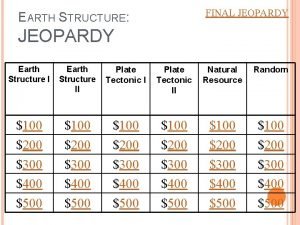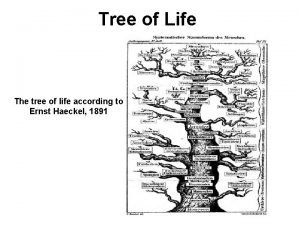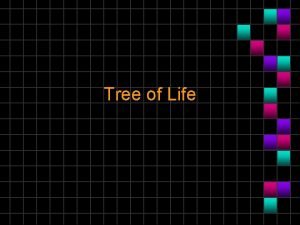Jeopardy The History of Life on Earth Tree



























- Slides: 27

Jeopardy The History of Life on Earth Tree of Life $100 $100 $200 $200 $300 $300 $400 $400 $500 $500 Intro to Cell Prokaryotes Division Final Jeopardy Protists

1 - $100 n What kind of rocks are fossils found in? Sedimentary… n But it’s igneous and metamorphic rocks that can be radiometrically dated. So you just date these rocks that are near the sedimentary rocks to find out how old the fossils are. n

1 - $200 n Which came about first, prokaryotic cells or eukaryotic cells? Prokaryotic… n Prokaryotic evolved 3500 MYA, eukaryotic evolved 2000 MYA n Dr. Colbert doesn’t want you guys to remember specific dates, but he wants you to know relative times (what evolved before what) n

1 - $300 n What type of rocks are used for radiometric dating? n Igneous and metamorphic

1 - $400 Define fact n Define hypothesis n A fact is something that can be observed to occur n A hypothesis is really a prediction about what will happen in a certain set of circumstances. AKA an educated guess that is possible to test. n

1 - $500 n Explain the difference between a law and a theory. A law is a “universal relationship describing how the natural world behaves under specific conditions. Can often be expressed mathematically. n Theory means an explanation for a natural phenomenon that is well-supported by data, incorporates relevant laws, and makes accurate predictions. Well-supported scientific theories are not a “just”, an “opinion” or a “guess” – they are the very best explanations that science has to offer n

2 - $100 n What is the goal of taxonomy? n Name all species on planet Earth

2 - $200 n How do you write scientific names? What are the parts of a scientific name? Why do we use scientific names? The two parts are Genus and Species. Genus comes before species when you write it. Genus is always capitalized and species is always lower case. The whole thing should be italicized. We use scientific names to be more descriptive and specific. n Example: Homo sapiens n

2 - $300 n What is phylogeny? n Phylogeny is the history and relationships of groups of organisms. Typically represented by a “phylogenetic tree” showing “lineages” (groups of organisms related through common ancestry, also called a “clade” or “monophyletic group”

2 - $400 n What’s a taxon? What are the different taxonomic levels? n A group of organisms. The different levels are Domain, Kingdom, Phylum, Class, Order, Family, Genus, Species

2 - $500 n What is the difference between homology and homoplasy? n Homology is having a similar trait due to COMMON ANCESTRY. Homoplasy is having a similar trait NOT due to common ancestry.

3 - $100 n How do prokaryotic cells divide? n Binary fission

3 - $200 n What does binary fission produce? n Two genetically identical daughter cells (have the same DNA sequence)

3 - $300 n What does mitosis produce? n Two genetically identical daughter cells (same DNA sequence)

3 - $400 n What does Meiosis produce? Four genetically distinct HAPLOID daughter cells (each has own distinct DNA sequence) n Depending on the type of organism, meiosis may or may not lead directly to the production of gametes n

3 - $500 n What is the difference between binary fission and mitosis? n They have the same overall result (two genetically identical daughter cells) BUT they occur by different processes AKA they achieve this same result but each do it a different way

4 - $100 n What are the four common shapes of prokaryotes? What do they look like? n Cocci – spheres Bacilli – rods Vibrios – comma Spirilla – spiral n n n

4 - $200 n What is the difference between an autotroph and heterotroph? n Autotrophs self-synthesize (make their own food) and heterotrophs have to eat other organisms

4 - $300 Name and describe the four different ways prokaryotes use oxygen. n n Obligate aerobes – need oxygen to survive Facultative anaerobes - can use oxygen, but don’t need it Aerotolerant anaerobes – don’t use it but aren’t poisoned by it Obligate anaerobes – poisoned by oxygen

4 - $400 n True or False: Archaens have peptidoglycan in their cell walls while Bacteria and Eukaryotes do not. n FALSE – Bacteria have peptidoglycan in their cells walls. Archaens and Eukaryotes do not.

4 - $500 n What is this? Does it belong to domain bacteria or domain archaea? How does it obtain nutrition? Is it unicellular or multicellular? n Cyanobacteria; Domain Bacteria; Photoautotroph; Multicellular

5 - $100 n What groups of organisms have eukaryotic cells? n Animals Plants Fungi Protists n n n

5 - $200 n What are three major lineagesof Alveolata? What are they characterized by? n Ciliates, Dinoflagellates and Apiocomplexans. Characterized by presence of small membranebounded cavities (alveoli) under their cell membrane (only visible with electron microscopes)

5 - $300 n What’s this? What lineage is it a member of? n Diatoms; Stamenopilla

5 - $400 n What are the major lineages of amoebozoa? n Lobose amoebae, cellular slime molds, plasmodial slime molds

5 - $500 n Describe the endosymbiont theory. Is there evidence that supports this theory? If yes, what? n A theory stating that the eukaryotes evolved through a process whereby different types of free-living prokaryotes became incorporated inside larger prokaryotic cells and eventually developed into mitochondria, chloroplasts, and possibly other organelles. Evidence: n Plastids and mitochondria are about the same size as typical prokaryotic cells n Reproduce by a process similar to binary fission n Contain circular DNA molecules n

Final Jeopardy n What lineage of protists does this organism belong to? Is this eukaryotic or prokaryotic organism? What nutritional strategy does this organism use? Plantae / green algae n Eukaryotic – you can tell because of the nucleus n Photoautotroph – you can tell because of the green chloroplasts. Chloroplasts = photosynthesis n
 Hhmi deep history of life on earth
Hhmi deep history of life on earth History of life on earth
History of life on earth The history of life on earth
The history of life on earth Earth science jeopardy 8th grade
Earth science jeopardy 8th grade Plate tectonics jeopardy
Plate tectonics jeopardy Earth science jeopardy
Earth science jeopardy Earth science jeopardy
Earth science jeopardy Earth day plant a tree
Earth day plant a tree Hát kết hợp bộ gõ cơ thể
Hát kết hợp bộ gõ cơ thể Slidetodoc
Slidetodoc Bổ thể
Bổ thể Tỉ lệ cơ thể trẻ em
Tỉ lệ cơ thể trẻ em Voi kéo gỗ như thế nào
Voi kéo gỗ như thế nào Chụp phim tư thế worms-breton
Chụp phim tư thế worms-breton Alleluia hat len nguoi oi
Alleluia hat len nguoi oi Môn thể thao bắt đầu bằng chữ đua
Môn thể thao bắt đầu bằng chữ đua Thế nào là hệ số cao nhất
Thế nào là hệ số cao nhất Các châu lục và đại dương trên thế giới
Các châu lục và đại dương trên thế giới Công của trọng lực
Công của trọng lực Trời xanh đây là của chúng ta thể thơ
Trời xanh đây là của chúng ta thể thơ Mật thư anh em như thể tay chân
Mật thư anh em như thể tay chân Làm thế nào để 102-1=99
Làm thế nào để 102-1=99 Phản ứng thế ankan
Phản ứng thế ankan Các châu lục và đại dương trên thế giới
Các châu lục và đại dương trên thế giới Thơ thất ngôn tứ tuyệt đường luật
Thơ thất ngôn tứ tuyệt đường luật Quá trình desamine hóa có thể tạo ra
Quá trình desamine hóa có thể tạo ra Một số thể thơ truyền thống
Một số thể thơ truyền thống Bàn tay mà dây bẩn
Bàn tay mà dây bẩn
